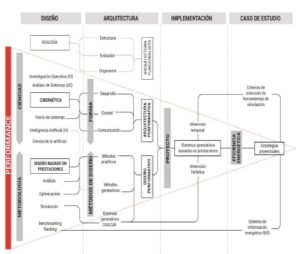Ms. Manuela Ianni’s Thesis Lecture

Diseño basado en prestaciones en la arquitectura. Estrategias proyectuales para mejorar la eficiencia energética de los edificios
Author: Ianni -, Manuela
Director: PhD. Madrazo Agudín, Leandro
Date: 12th of April of 2018
Tribunal: PhD. Hernández Miguillón, Rufino Javier; PhD. Coch Roura, Helena; PhD. López Mesa, Belinda.
Abstract: Reducing energy consumption has become a priority for contemporary architecture. Consequently, methods and tools to effectively design energy-efficient buildings are needed. Performance-based design (PBD) is a design method that aims to improve decision making during the design process in order to ensure that, once built, a building will meet the predefined requirements. PBD emerged from Operational Research (OR) and Systems Analysis (SA), two disciplines developed during the Second World War to improve military decision-making.
PBD was used to “simulate” alternative solutions using mathematical models and computer technology, in order to choose the one that best met some previously determined objectives. One of its main advantages was the reduction of errors in decision making, while its most outstanding products were technological devices such as missiles and rockets, and also the computer. During the second half of the 20th century, PBD began to be introduced in the field of architecture. The concept of performance was played against the notion of function, which prevailed in the architectural discourse since the 19th century and was a dogmatic idea of the modern movement.
While the notion of function in architecture focused on the representative character of the building, that is, the capacity of the form to express the function in aesthetic terms, on the other hand, the concept of performance emphasized on the operability of the building. This entailed considering the building as a technological product, or an artefact with some objectives to fulfil, instead of an artistic and meaningful object.
Design methods were developed in order to integrate PBD in architectural design, with the objective of easing the search of a form suitable to program needs, by applying techniques and tools used in the creation of technological products. Although these design methods were postulated as a solution to increasingly complex problems, they did not have the expected effect.
It became then evident the impossibility to dispense with the aesthetic and symbolic qualities of architecture, which the PBD, as it was being applied in systems engineering, ignored. Postmodern architecture remarked that one of the functions of architecture was to communicate and, therefore, it applied linguistic theories to explain the mechanisms by which architectural forms acquire meaning.
The advances in simulation tools at the end of the 20th century led to reconsider the need for PBD in architecture: it was no longer meant to be a method to create buildings capable of fulfilling predefined requirements, but rather to explore formal possibilities using the performance values as inputs to the design process.
This process of generating the form considering its performance gave rise to buildings such as the City Hall London (2002) and the Swiss Re Building (2004) by Norman Foster, and the Bird's Nest (2008) and Beijing National Stadium (2009) by Herzog & De Meuron; buildings that are socially, culturally and economically meaningful and at the same time aspire to be efficient from the constructive and energetic perspective.
These works exemplify the so-called “performative architecture”, which is the result of a “performative design”; that is, a generative process driven by performance. The purpose of this thesis is to understand and assess the potential of PBD to design and build energy-efficient buildings.
This purpose entails, in the first place, facing up fundamental questions such as the artistic and scientific nature of architecture, the systematization of the design process and the role of the computer in this process, and finally, the artistic and technological nature of a building. It also implies identifying the problems that must be overcome in order to strengthen the use of PBD in architectural design, and suggesting solutions to them.
Nowadays, the application of PBD in the design of energy-efficient buildings is still limited. This is evidenced by the fact that, in professional practices, simulation tools are mainly used in the final stages of the design in order to check regulations or to obtain an energy certification, instead of being applied to support decision making throughout the entire building design process, from its initial phases to its construction and subsequent use.
In the absence of methods and tools that facilitate a decision-making process based on reliable and verifiable information, some crucial decisions that determine the energy efficiency of a building are taken intuitively, on the basis of the experience and knowledge of the designers.
Therefore, there is a need of developing strategies to integrate the methodology based on PBD in the design process. For that purpose, the design process of a residential building designed to comply with current energy efficiency regulations has been analysed, in order to propose an alternative design process based on PBD.
The comparison of both processes, the one that was applied in the construction of the building and the alternative process based on PBD, made it possible to verify the effectiveness of the proposed design strategies to create energy-efficient buildings.

Add new comment